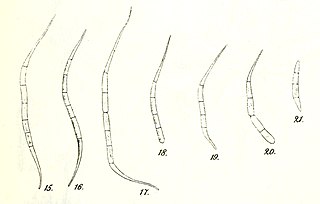
The Stramenopiles, also called Heterokonts, are a clade of organisms distinguished by the presence of stiff tripartite external hairs. In most species, the hairs are attached to flagella, in some they are attached to other areas of the cellular surface, and in some they have been secondarily lost. Stramenopiles represent one of the three major clades in the SAR supergroup, along with Alveolata and Rhizaria.

The silicoflagellates are a small group of unicellular photosynthetic protists, or algae, belonging to the supergroup of eukaryotes known as Stramenopiles. They behave as plankton and are present in oceanic waters. They are well-known from harmful algal blooms that cause high mortality of fish. Additionally, they compose a rich fossil record represented by their silica skeletons.
Struvea is a genus of green macroalgae in the family Boodleaceae.

Gambierdiscus toxicus is a species of photosynthetic unicellular eukaryote belonging to the Alveolata, part of the SAR supergroup. It is a dinoflagellate which can cause the foodborne illness ciguatera, and is known to produce several natural polyethers including ciguatoxin, maitotoxin, gambieric acid, and gambierol. The species was discovered attached to the surface of brown macroalgae.

In biology, a phylum is a level of classification or taxonomic rank below kingdom and above class. Traditionally, in botany the term division has been used instead of phylum, although the International Code of Nomenclature for algae, fungi, and plants accepts the terms as equivalent. Depending on definitions, the animal kingdom Animalia contains about 31 phyla, the plant kingdom Plantae contains about 14 phyla, and the fungus kingdom Fungi contains about 8 phyla. Current research in phylogenetics is uncovering the relationships among phyla within larger clades like Ecdysozoa and Embryophyta.
Grethe Berit Rytter Hasle was a Norwegian planktologist. Among the first female professors of natural science at the University of Oslo, she specialized in the study of phytoplankton.

Dictyochophyceae sensu lato is a photosynthetic lineage of heterokont algae.

Prymnesium is a genus of haptophytes, including the species Prymnesium parvum. The genus is a unicellular motile alga. It is ellipsoidal in shape one flagellum is straight and there are two longer ones which enable movement.
Florenciella is a genus of heterokonts.

Raphidonema is a genus of filamentous green alga comprising five species. It is a member of the Trebouxiophyceae.
Chattonella is a genus of the marine class raphidophytes associated with red tides and can be found in the phylum Heterokontophyta in stramenopiles. These unicellular flagellates are found in brackish ecosystems. The genus Chattonella is composed of five species: C. subsalsa, C. antiqua, C. marina, C. minima, and C. ovata.
Blidingia dawsonii is a species of seaweed from a family of Ulvaceae that can be found in Canada, Mexico, and US states such as California and Washington. It was described by Hollenberg & I.A.Abbott in 1968. The species are disputed over genus, which some believe to be Percursaria.
Gambierdiscus belizeanus is a species of dinoflagellate, first found in Belize.
Heterocapsa circularisquama is a species of dinoflagellate notable for the production of a biotoxin affecting marine fauna. It is known to produce large red tides off western Japan, causing high bivalve mortality, particularly pearl oysters. It is very similar to Heterocapsa illdefina, however H. circularisquama carries six radiating ridges on its circular basal plate, and its scales have longer spines, among other subtle differences in morphology.

Christine Adair Maggs is a British phycologist. Formerly Executive Dean of the Faculty of Science & Technology at Bournemouth University, she was the first Chief Scientist of the Joint Nature Conservation Committee, retiring in 2022. She is now an independent non-executive Director of Ocean Harvest Technology https://oceanharvesttechnology.com/corporate-governance/board-of-directors/

Batrachospermaceae is a family of fresh water red algae (Rhodophyta). Genera within the Batrachospermaceae generally have a "Lemanea-type" life history with carpospores germinating to produce chantransia. Sporophyte phase with meiosis occurs in an apical cell to produce the gametophyte stage. Pit connections have two pit plug cap layers with the other layer enlarged. This family of freshwater red algae is uniaxial, meaning each filament with a single apical cell. The genera included within Batrachospermaceae are listed in the table below.

Timothy (Tim) John Entwisle, is an Australian botanist, much of whose research work is in phycology (algae). See for example the articles. He was awarded a Ph.D. from La Trobe University in 1986 for work on the taxonomy of Vaucheria.

Pyrophyllon subtumens is an obligate red algal epiphyte of Durvillaea southern bull-kelp, and is endemic to New Zealand.

The Gracilariaceae is a small family of red algae containing several genera of agarophytes. It has a world-wide distribution. 24 species are found in China, and 6 species are found in Great Britain and Ireland. It is found in Australia and Chile.

Gyrista is a phylum of heterokont protists containing three diverse groups: the mostly photosynthetic Ochrophyta, the parasitic Pseudofungi, and the recently described group of nanoflagellates known as Bigyromonada. Members of this phylum are characterized by the presence of a helix or a double helix/ring system in the ciliary transition region.











